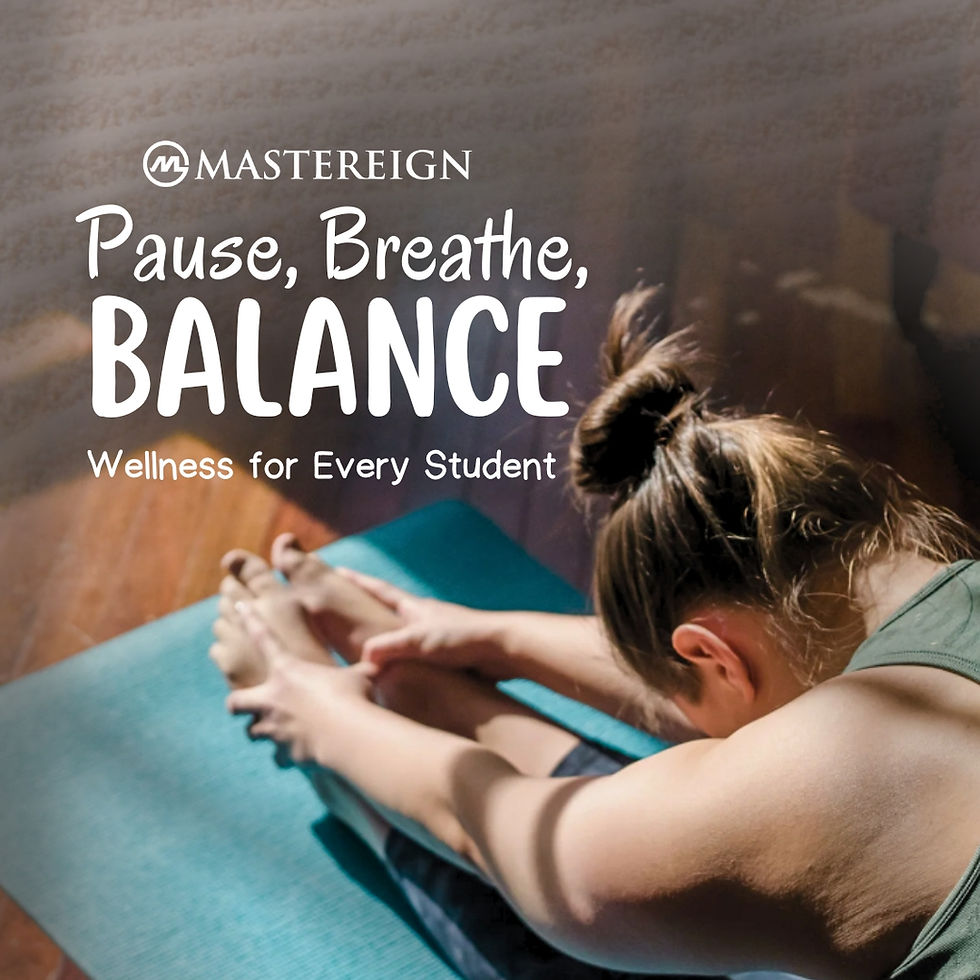Pause, Breathe, Balance: Supporting Student Wellness Through Everyday Practices
- mastereign
- Aug 8
- 2 min read

In today’s fast-paced, high-expectation learning environment, student well-being is more than just a buzzword. It’s becoming a critical component of effective education. As classrooms become more diverse and emotionally complex, educators are increasingly turning to holistic practices that support the whole child, not just academically, but socially, physically, and emotionally.
One such approach is the integration of simple wellness routines into the school day—practices that help students pause, breathe, and regain balance.
What Wellness in Schools Really Looks Like
Wellness in an educational setting doesn’t always mean structured PE lessons or one-off motivational talks. It can be something as simple as:
A morning stretch before class starts
A short breathing exercise to reset after recess
A reflection activity using gratitude or intention setting
Learning about nutritious food in a hands-on cooking session
Talking about how to listen to your body when it’s tired or overwhelmed
These micro-moments, when integrated consistently, build the foundations for emotional regulation, empathy, focus, and resilience.
Why Student Wellness Matters (Especially in Primary School)
For children in lower and upper primary, daily routines shape their sense of safety and confidence. Students in this age group are learning how to name their emotions, manage stress, build social relationships, and navigate failures.
Wellness-based activities provide students with:
Language for feelings
Tools for self-regulation
Healthy routines that they can carry into adolescence
Whether it’s a quiet breathing moment after a loud assembly or a quick self-check-in before a spelling quiz, these habits teach students that it’s okay to slow down and reconnect with themselves.
A Blend of Movement, Mindfulness, and Practical Habits
When students take part in wellness activities, such as basic yoga poses, preparing simple healthy meals, or learning about sleep and hydration, they begin to understand the interconnectedness of body, mind, and heart.
These lessons extend far beyond health education. They reinforce values like:
Self-awareness
Respect for self and others
Independence and responsibility
Self-compassion during setbacks
More importantly, they foster a calm, regulated learning environment where everyone can thrive.
A Shared Role Between Teachers and Adults
Teachers often implement these practices without fanfare, playing calming music during writing tasks, encouraging movement breaks between lessons, or noticing when a student needs time alone. These are acts of care that contribute to the broader culture of wellness in a school.
But parents and caregivers also play a vital role. When wellness is mirrored at home, whether through shared meals, screen-free routines, or conversations about emotions, children receive a consistent message: your wellbeing matters.

Not an Extra Task, But a Different Lens
One of the challenges in schools today is time. With curriculum demands and administrative responsibilities, teachers often feel there’s little room for “extras.”
But wellness isn’t an “extra.” It’s a lens through which learning can happen more smoothly. When students are calm, self-aware, and emotionally safe, they engage more meaningfully with lessons. They listen better. They try harder. They build better relationships.
Every Classroom Can Be a Calmer Space
You don’t need to be a certified yoga teacher or mental health expert to support wellness in your classroom or home. Small, mindful routines done with care and consistency have a lasting impact.
In the end, helping students pause, breathe, and balance isn’t about changing the way we teach. It’s about supporting how they learn to live.



